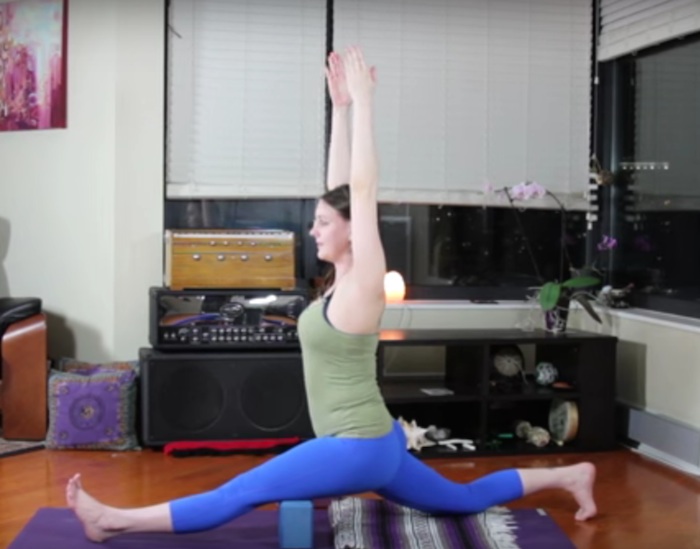
Editor’s Note: We lovingly assume zero liability for the choices you make on or off the mat. Be kind to your body!
For many yoga students, full splits pose represents a challenge to be conquered.
When we really want something, we’ll do just about anything to get it, even if it means working past our place of safety and comfort.
Although this is an unbalanced approach to the pose, it’s normal, especially if we’re prone to a competitive mindset. Our minds are capable of rationalizing our experience, and are imbued with visions of the past and future, which makes us want to “go farther” in the pose than we did last time, and go even farther the next time we practice.
I have these mental tendencies in me, and if you practice yoga regularly, you’ve probably experienced a little bit of this in you, too. I’ve even abandoned my project poses, like full splits pose, altogether for distinct periods of time, in order to allow my mindset to shift into other patterns of thinking and observing.
But I always return to them eventually because they offer me something totally unique: the opportunity to observe how my mind reacts when I try something new. This is important training ground for my mind, because it illumines my tendencies toward aggression, insecurity and anxiety. It is far easier for me to observe how I’m being triggered as I approach a challenging yoga pose than it is for me to observe myself being triggered in an argument with a loved one or a disgruntled interaction with a customer service rep.
No matter what project pose I’m working on—whether it calls for extreme physical strength, flexibility or balance—I am called to observe how I participate in my experiences, and the clarity of this observation is what allows my dysfunctional habits to dissolve.
What is full splits pose and why should we practice it?
Full splits pose is half forward fold and half backbend.
A forward fold is characterized by hip flexion (when the thigh bone moves in front of the pelvis) and a backbend is characterized by hip extension (when the thigh bone moves behind the pelvis). Full splits takes these opposite actions and divides them between the two legs allowing each leg to experience unique joint placement and muscular effort. The torso, meanwhile, must also balance the efforts of hip flexion and hip extension, and because the efforts of these opposite actions tend to cancel each other out, the upper body is able to enjoy a buoyant and integrated tadasana-esque position.
This is not an easy feat to accomplish, especially if you encounter muscular tightness in the legs and hips (which can change over time) or skeletal limitation in the hip joints and/or spine (which most of the time cannot change over time). All of these factors will determine the accessibility and comfort of the pose in your body.
Because most people encounter resistance of some type while trying the posture, full splits is actually a great project pose because it offers so many variations of success. The pose does not demand that the pelvis reach the floor, it doesn’t demand the front leg to move fully into its forward fold position, and it doesn’t require the back leg to move fully into its backbend position. It simply requires the practitioner to move intelligently within the trajectory of its movement. Even the most inflexible minds and bodies are capable of experiencing the seed positions of full splits, and are able to reap the benefits thereof.
For me, the benefits of full splits are largely mental, and include a greater acceptance of my body and its (perceived) limitations, a sense of gentleness and ease as I try new things, and noticing how my mind reacts when I do or do not reach an arbitrarily set goal.
The physical benefits include integration through the hip joint and surrounding joint structures, strengthening of the core as a way of maintaining upper body balance and buoyancy, a better understanding of related pose types (like forward folds, backbends and other hip openers), and a greater intelligence pertaining to proprioception (or understanding, through experience, where the body is in space).
Notice that none of the benefits listed above have anything to do with “going deeper” into the pose, achieving more flexibility, or being “really, really good at yoga”.
In fact, the next time you find someone who has a truly integrated full splits pose (you’ll know because the pelvis will be squared forward and it won’t seem like their legs are spilling out uncontrollably from their hip sockets), ask them how long it took them to achieve this variation. Unless they have a physical background in dance, gymnastics or other sports that boost flexibility, they’ll probably say something like, “ten years”. The pose takes a long time! It takes consistency and ambivalence towards achievement. It takes accepting each moment as it happens and moving without desire.
And the best part is, full splits lets you work on it a little bit at a time, millimeter by millimeter.
What should we remember as we approach the pose?
The biggest assumption about this posture is that full splits is primarily a pose for flexibility. I wholeheartedly disagree with this, unless you enjoy injured hamstrings and hip flexors.
Rather, when practiced correctly, the thighs will plug in to the pelvis as they stretch in opposite directions, and the stretch will naturally deepen over time depending on your body’s receptivity to muscular change.
Full splits reveals our human tendency to shy away from things we think we are not good at. Because full splits pose is often regarded as a pose for flexibility, students who are already very flexible often embrace this pose as an opportunity to show off or “go deep” without much regard for the integration aspects of this pose; and students who are prone to strength (and therefor muscular tightness) often shy away from this pose, thinking that they aren’t built for it, good enough for it, etc. These tendencies result in flexible people smashing their pelvis’ to the ground in full splits come hell or high water, and tight people curling into a child’s pose in defeat for the duration of the work.
Both of these positions are narrow-sighted and miss the mark of what we’re really accomplishing by practicing full splits. This pose offers us the possibility of uniting and expanding the relationship between our flexibility and our strength. It offers us the possibility of being supremely balanced between the opposites in our lives, and to find peace among chaos. It offers us the possibility of knowing ourselves more fully, and taking responsibility for the psychological patterns that create suffering in our lives.
Instead, we should embrace our practice outside the context of our wants, likes, dislikes and phobias.
We should understand that a warm muscle is an open muscle (since the first pre-requisite of stretching is heat), and that our flexibility should be enjoyed, not forced. Our job is not to push the limits of our flexibility, but rather, warm our muscles enough that they allow a natural give (whether that “give” is more or less than yesterday’s “give” is really none of our business). We should understand that integration is foundational to any yoga pose, and that proper integration is our armor against physical injury and mental defeat. Finally, we should work with intelligent sequencing and guidance, seeking out practices and teachers that bring out the best in us and our yoga poses.
Ready to practice?
Here is a 45 minute practice I filmed dedicated to full splits. While this article dives into the psychological underpinnings that draw us either to or away from the pose, the filmed practice is mostly dedicated to a correct sequencing of the necessary preparatory postures, which will warm your muscles for maximum stretch and introduce the hips to the mandatory integration required for the peak pose.
I recommend two yoga blocks for this practice (you’ll see why when we do the full pose), but if you don’t have blocks, feel free to substitute other block-size household objects (a fat book or short stack of books works well, and you can easily modify the height by adding or subtracting books from your pile).
Thanks for reading, and enjoy your practice!
Namaste.
Full Splits Flow with Brentan Schellenbach
Author: Brentan Schellenbach
Editor: Renée Picard
Image: Screenshot











Read 0 comments and reply